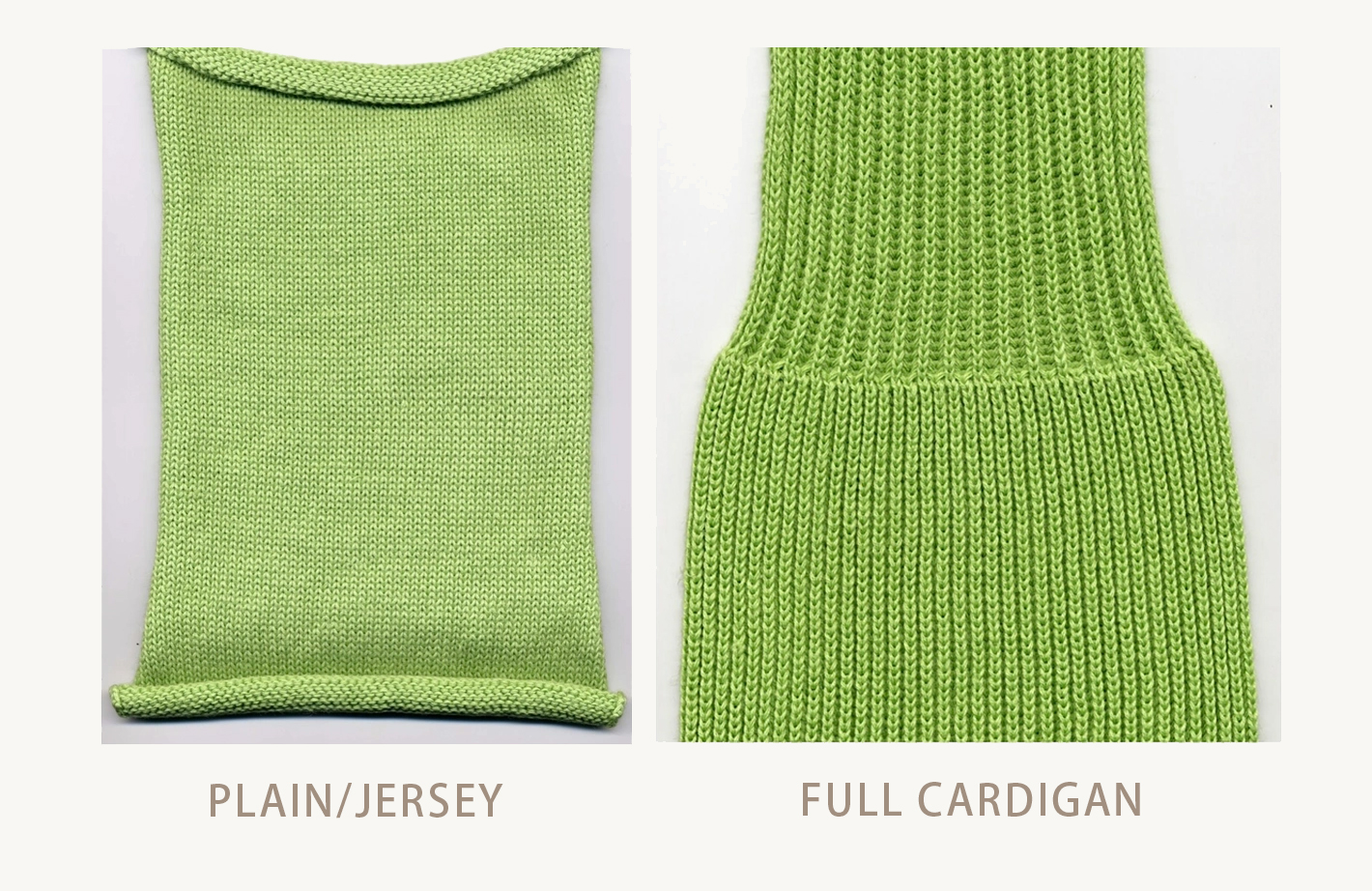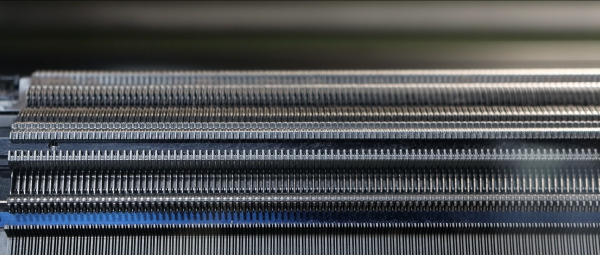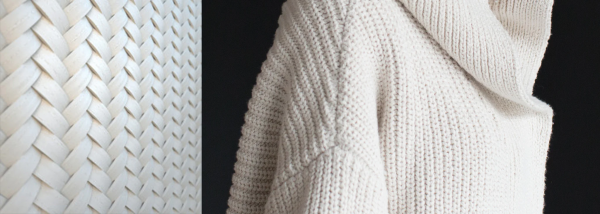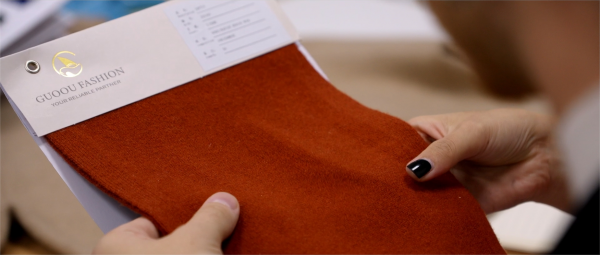Свитера индивидуальной вязки больше не ограничиваются эксклюзивной школьной формой или элитными бутиками. Сегодня они стали символом индивидуального стиля и брендинга, украшая все: от корпоративных команд до влиятельных лиц в социальных сетях.
Сейчас потребители все чаще ищут уникальные предметы, отражающие их индивидуальность. Свитера индивидуальной вязки позволяют полностью контролировать дизайн и выразить индивидуальность вашего бренда. Развитие технологий вязания также упростило процесс производства свитеров на заказ. Это, в свою очередь, сделало его более доступным и доступным для малого бизнеса. А онлайн-платформы упростили общение с производителями трикотажных изделий на заказ, создавая глобальный рынок с широким спектром возможностей.
Однако, впервые знакомясь с трикотажем на заказ, часто возникает один вопрос: «Сколько это стоит?» Ответ, к сожалению, не простой. На стоимость свитера индивидуальной вязки влияет множество факторов, которые мы подробно рассмотрим в этом посте.
Итак, возьмите чашку чая, устраивайтесь поудобнее, и давайте разгадаем уравнение стоимости вязаного свитера вашей мечты на заказ!
Ключевые факторы, влияющие на стоимость свитеров индивидуальной вязки
Прояснение стоимости свитера, связанного на заказ, вашей мечты может показаться распутыванием клубка пряжи. Но не бойтесь! Понимая ключевые факторы, влияющие на цену, вы сможете уверенно ориентироваться в процессе. Вот разбивка основных элементов, которые влияют на окончательную стоимость:
Ключ 1: Выбор материала: ткань вашей мечты (и бюджета)

Тип выбранной вами пряжи играет большую роль в определении стоимости вашего свитера, связанного на заказ. Вот некоторые популярные варианты, а также их уникальные особенности и цены:
- Шерсть: Шерсть, известная своей теплотой, мягкостью и долговечностью, бывает различных сортов, например мериносовая шерсть и овечья шерсть. Как правило, более тонкая шерсть, такая как мериносовая, обычно стоит дороже.
- Кашемир: воплощение роскошной мягкости, кашемир создает непревзойденные ощущения, но имеет премиальную цену.
- Хлопок: дышащий и доступный вариант, хлопковые свитера идеально подходят для круглогодичного ношения. Органический хлопок или сорта хлопка пима могут незначительно повлиять на стоимость [https://textileexchange.org/app/uploads/2022/05/Challenges-FAQ-Guide-Getting-Started-2022.pdf]
- Акриловые смеси. Недорогие акриловые смеси, которые часто можно стирать в машине, являются популярным выбором для повседневной носки. Однако они могут быть более склонны к скатыванию (образованию маленьких шариков волокна на поверхности ткани).
- Альпака: волокно альпаки, известное своей теплотой, мягкостью и долговечностью, может быть более дорогим из-за ограниченного производства.https://en.wikipedia.org/wiki/Alpaca_fiber].
- Лен: экологически чистый вариант, лен предлагает экологичный и дышащий выбор. Однако могут потребоваться особые инструкции по уходу.
- Переработанные волокна. Выбор переработанных материалов может добавить элемент экологичности вашему индивидуальному свитеру, что потенциально повлияет на стоимость в зависимости от используемой обработки.
Ознакомьтесь с публикацией в нашем блоге «5 основных советов по выбору материала для трикотажа на заказ» для более детального сравнения тканей.
Чтобы узнать больше об экологически чистых материалах для изготовления экологически чистых свитеров на заказ, вы можете связаться с нами, и мы бесплатно предоставим вам больше решений для пряжи.
Помните, что идеальный выбор материала зависит от желаемого внешнего вида, бюджета и предполагаемого использования свитера.
Ключ 2: Сложность дизайна свитера
Красота свитеров, связанных на заказ, заключается в их способности превращаться из простых вещей в произведения замысловатого дизайна. Однако сложность конструкции также может повлиять на общую стоимость. Вот более детальный взгляд на то, как различные элементы дизайна влияют на цену:
- Вязание: некоторые красивые рельефные узоры, например, вязание косами, добавляют текстуру и визуальный интерес. Но будьте осторожны! Для создания приподнятых тросов требуется больше пряжи и дополнительная рабочая сила для их вязания. Это приводит к более высокой стоимости по сравнению с более простыми узорами вязания.
Аналогичным образом, для создания по-настоящему сложных дизайнов со сложными деталями и логотипами в игру вступает жаккардовое плетение. В этой технике используется специальный ткацкий станок для создания сложных узоров непосредственно на ткани, что часто требует специальных навыков и более высокой цены.https://en.wikipedia.org/wiki/Jacquard_machine]
- Цветовая работа: хотите добавить ярких красок с помощью пряжи разных цветов? Несмотря на потрясающий внешний вид, цветные узоры требуют большего количества смены пряжи и планирования, что увеличивает время производства и, возможно, стоимость.
- Экстравагантное украшение: добавление блесток с помощью бус, пайеток или заплаток может персонализировать ваш свитер. Однако эти украшения обычно требуют дополнительного времени и труда для надежного крепления, что влияет на конечную стоимость.
- Стежки и скорость. Тип используемого трикотажного стежка также может незначительно влиять на скорость производства и, возможно, на стоимость. Вот краткий обзор двух распространенных швов:

- Трикотажная строчка: этот основной стежок создает гладкую, ровную ткань и, как правило, самый быстрый в вязании, что потенциально снижает затраты.
- Полный стежок кардигана: этот стежок создает ребристую текстуру, и его вязание немного медленнее по сравнению с лицевой гладью. Хотя разница в стоимости может быть минимальной, этот фактор следует учитывать при очень больших или сложных проектах.
Ключ 3: Материал Втвосемь
Когда дело доходит до вязаных свитеров на заказ, вес материала играет решающую роль как в функциональности, так и в стоимости. Но что именно влияет на вес вашего свитера и как это влияет на цену? Давайте распутаем эту тайну, связанную с пряжей:
- Игла

Как кисти бывают разных размеров, так и вязальные спицы бывают разных размеров. Размер иглы, которую вы выбираете в зависимости от узора, который вы создаете, или желаемой функциональности, может существенно повлиять на вес вашего окончательного свитера.
- Более толстые иглы (например, 3GG или 5GG): эти иглы создают более крупные стежки, в результате чего получается более толстый и объемный свитер, для которого требуется больше пряжи, что потенциально увеличивает стоимость.
- Более тонкие иглы (например, 12GG или 14GG): эти иглы создают меньшие стежки, что позволяет получить более легкий и нежный свитер, для которого требуется меньше пряжи, что потенциально снижает стоимость.
- Стежки: от джерси до полукардигана.
Конкретная техника вязания (или “вязать”) также может влиять на вес. Вот два распространенных примера:

- Трикотажная строчка: эта основная строчка создает гладкую, ровную ткань средней плотности.
- Стежок полукардигана: этот стежок создает более толстую и текстурированную ткань по сравнению с трикотажным стежком. Свитера, полностью связанные стежком полукардигана, естественно, будут тяжелее и потенциально дороже, чем свитера, связанные стежком джерси.
- Наложение слоев для увеличения толщины: игра с количеством пряжи
Иногда концепция дизайна может потребовать использования более толстой ткани без изменения размера иглы. В таких случаях производители могут регулировать вес, используя больше пряжи.
- Одинарная нить: это наиболее распространенный подход, при котором для создания свитера используется одна нить пряжи.
- Двойная или несколько нитей: если требуется более толстая ткань, производители могут использовать две или более нити пряжи, скрепляемые вместе во время вязания. Это, естественно, увеличивает вес и, возможно, стоимость.
- Сама пряжа: вопрос неотъемлемого веса
Различные типы пряжи по своей природе имеют разный вес. Вот быстрое сравнение:

- Более легкая пряжа: кашемир, известный своей роскошной мягкостью, представляет собой легкую пряжу. Свитера из кашемира, естественно, будут легче, чем из более тяжелой пряжи.
- Более тяжелая пряжа: пряжа из смесовой вискозы гладкая, прохладная, антистатическая и прекрасно окрашивается, что делает ее подходящей для весеннего и летнего трикотажа, но, естественно, она тяжелее, чем более легкая пряжа.
Понимание взаимодействия между этими факторами — размером иглы, типом вязания, количеством пряжи и собственным весом пряжи — позволит вам сделать осознанный выбор относительно веса и потенциальной стоимости вашего свитера, связанного по индивидуальному заказу.
Ключ 4: Уровень настройки
Свитера индивидуальной вязки отличаются своей способностью персонализироваться, но эти настройки также могут повлиять на стоимость. Давайте углубимся в то, как различные варианты настройки влияют на цену:
- Логотип Любовь
Добавление логотипа на свитер может повысить индивидуальность вашего бренда. Однако сложность логотипа существенно влияет на стоимость. И вот почему: маленький простой логотип обычно обходится дешевле, чем большой и сложный со множеством деталей. Выбранный способ нанесения логотипа также играет роль. Вышивка выглядит классически и профессионально, но сложные дизайны могут стоить дороже. Аппликация включает в себя прикрепление предварительно вырезанных фигур из ткани, что может быть более быстрым и потенциально более доступным вариантом для создания более простых логотипов. Вышивка синелью придает текстурированный рельефный эффект, но может быть дороже из-за используемых специальных материалов.
Между тем, уникальные украшения, от функциональных пуговиц и молний до стильных кисточек и отделки, могут сделать ваш индивидуальный свитер более изысканным. Однако каждое украшение требует дополнительной настройки, что требует дополнительного времени и материалов, что потенциально влияет на цену.
- Идентичность бренда изнутри: индивидуальные этикетки
Чтобы вывести ваш индивидуальный свитер на новый уровень, часто требуются специальные этикетки. Они могут включать в себя:

- Основная этикетка: идентифицирует ваш бренд и предоставляет такую информацию, как уход за одеждой.
- Этикетка с размером. Для обеспечения правильной посадки необходима точная маркировка размера.
- Этикетка по уходу: четкие инструкции по уходу помогут сохранить качество вашего свитера.
- Повесьте бирки: эти информативные бирки могут продемонстрировать информацию о вашем бренде и продукте.
- Упаковочные пакеты: индивидуальная упаковка добавляет профессиональный вид и может быть учтена в общей стоимости.
Хотя индивидуальные этикетки могут улучшить презентацию вашего бренда, они добавляют еще один уровень персонализации, который может повлиять на конечную цену.
Понимая, как параметры настройки влияют на стоимость, вы можете найти баланс между добавлением индивидуальности и сохранением бюджета.
Ключ 5: Подсчет количества заказа
Количество заказанных вами свитеров может существенно повлиять на общую стоимость за единицу. Этот экономический принцип, известный как “экономия на масштабе” играет решающую роль в производстве трикотажных изделий на заказ.
Представьте, что у производителя есть фиксированные затраты, связанные с организацией производства свитера определенного дизайна. Эти затраты могут включать создание образца, подготовку оборудования и поиск материалов. Независимо от того, производятся ли они 10 свитеров или 100, эти первоначальные затраты остаются относительно постоянными.
Вот тут-то и вступает в игру эффект масштаба. Когда вы заказываете большее количество, производитель может распределить эти фиксированные затраты на большее количество единиц. Это приводит к снижению стоимости свитера, что делает более крупные заказы более доступными в расчете на единицу продукции.
Многие производители трикотажных изделий на заказ устанавливают минимальный объем заказа (MOQ). Это относится к минимальному количеству свитеров, необходимых для одного заказа, обычно для определенного стиля и цвета. Знание минимального заказа позволяет эффективно планировать производство.
Например, в ГОУ МОДАНаш минимальный заказ составляет 100 штук каждого стиля/цвета. Это означает, что ваш первоначальный заказ должен включать не менее 100 свитеров одного дизайна и цвета. Хотя для небольших предприятий или личных проектов это может показаться большой цифрой, важно учитывать экономическую выгоду, связанную с более крупными заказами.
Получите БВосток Вценить Данаш Срот Кгнида СПожиратель
Теперь, когда вы прояснили факторы, влияющие на стоимость свитеров индивидуальной вязки, пришло время применить эти знания на практике! Вот несколько ключевых советов, которые помогут вам получить максимальную отдачу от своих инвестиций:
- Присмотритесь к ценам и сравните предложения
Не соглашайтесь на первое полученное предложение. Получите предложения как минимум от 3 различных производителей трикотажа на заказ. Это позволяет вам сравнивать структуру цен, время выполнения работ и общие предложения услуг. Однако помните, что самая низкая цена не должна быть единственным решающим фактором.
Обратите внимание: отдавайте приоритет качеству и ищите производителей с проверенной репутацией в области высококачественного изготовления и материалов, например, имеющих сертификаты BSCI/GRS.
- Время имеет решающее значение: учитывая время выполнения работ
При сравнении предложений учитывайте время выполнения работ (производство и доставка) наряду с ценой. Это особенно важно для срочных заказов. При запросе цен четко сообщите желаемый срок каждому производителю. Это позволяет им дать точную оценку того, когда вы можете ожидать доставки ваших свитеров, связанных по индивидуальному заказу.
Оптимизация затрат на ваш индивидуальный проект вязания
При выборе трикотажа на заказ очень важно учитывать бюджет. Вот несколько стратегий, которые помогут вам оптимизировать затраты без ущерба для качества:
- Сила переговоров: преимущества крупных заказов
Помните концепцию эффекта масштаба из Ключа 5? Здесь вступают в игру переговоры. После того, как вы определили производителя, которому доверяете, рассмотрите возможность договориться о немного более низкой цене при большем объеме заказа. Это усиливает способность производителя распределять фиксированные затраты на большее количество единиц, что потенциально может привести к снижению цены за единицу.
- Простота дизайна: меньше значит больше (иногда)
Хотя замысловатые конструкции могут быть потрясающими, они часто стоят дорого. Рассмотрите возможность упрощения конструкции, чтобы потенциально снизить затраты. Вот несколько идей:
- Сосредоточьтесь на одном ярком цвете или ограниченной цветовой палитре.
- Выбирайте классические и чистые силуэты вместо сложных узоров.
- Минимизируйте количество предлагаемых вами размеров, особенно для первоначальных заказов.
- Выбор материала: достижение баланса
Тип выбранной вами пряжи может существенно повлиять на стоимость вашего свитера. Хотя роскошные материалы, такие как кашемир, заманчивы, изучите альтернативные варианты, предлагающие хороший баланс качества и доступности.
Если, прочитав множество статей, вы так и не знаете, как конкретно выбрать пряжу. Это не имеет значения, ГОУ МОДА хорошо предлагает альтернативные решения для пряжи при предоставлении вам ценового предложения. Они могут использовать видео или присылать образцы, чтобы продемонстрировать ощущения и качество различных вариантов пряжи. Это позволит вам принять обоснованное решение, соответствующее вашему бюджету и желаемым характеристикам свитера. [Свяжитесь с нами для получения бесплатных решений по пряже]
Используя эти стратегии оптимизации затрат, вы можете создавать красивые свитера индивидуальной вязки, соответствующие вашему бюджету, не жертвуя качеством или стилем. Помните, что небольшое планирование и принятие стратегических решений могут во многом помочь воплотить ваше видение в жизнь.
Заключение
Мир свитеров индивидуальной вязки предлагает безграничные возможности для индивидуального стиля и брендинга. Но вместе с этой творческой свободой возникает вопрос: сколько это стоит? Хотя универсального ответа не существует, понимание ключевых факторов, влияющих на цену, позволит вам принимать обоснованные решения.
Помня об этих факторах, вы можете с уверенностью подходить к индивидуальному проектированию трикотажных изделий. Помните, что небольшое планирование и сотрудничество с таким известным производителем, как GUOOU FASHION, могут превратить ваше видение в красивый персонализированный свитер, который не выйдет за рамки вашего бюджета.
Нажмите здесь, чтобы узнать больше о ГОУ МОДАпроизводственные возможности.
Теперь, когда вы вооружены этими знаниями, пришло время раскрыть свой творческий потенциал и создать вязаный свитер своей мечты!

 English
English Deutsch
Deutsch Français
Français Italiano
Italiano Español
Español Русский
Русский Polski
Polski Nederlands
Nederlands Svenska
Svenska
